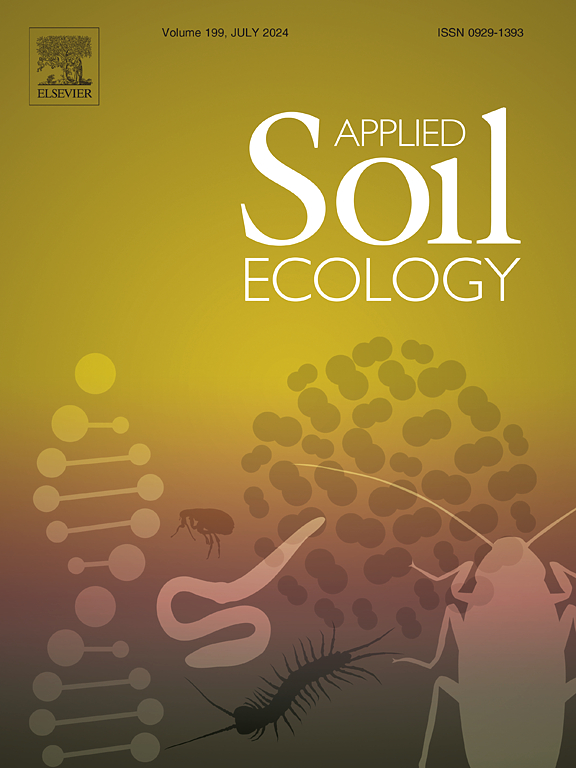High-quantity straw combined with microbial fertilizer positively drives soil multifunctionality and fertility in degraded arid desert ecosystems
IF 5
2区 农林科学
Q1 SOIL SCIENCE
引用次数: 0
Abstract
Combining straw incorporation with microbial fertilizer in soils has been widely recommended for improving soil function and productivity. However, the effects of high-quantity straw input and the introduction of microbial fertilizer on soil microbial diversity, functional attributes, and nutrient enhancement in degraded sandy soils are inadequately comprehended. Herein, we established a field trial with five treatments: low-quantity straw input (LS), high-quantity straw input (HS), low-quantity straw combined with microbial fertilizer (LSM), high-quantity straw combined with microbial fertilizer (HSM), and without straw and microbial fertilizer (Control). Results indicated that all amendment treatments had a positive impact on soil multifunctionality (SMF) and pivotal nutrient contents. Compared to the control, HSM increased the SMF, total nitrogen (TN), available nitrogen (AN) and available phosphorus (AP) by 205.56 %, 140.00 %, 133.58 %, and 100.00 %, respectively. Biomaterials input reduced fungal richness and bacterial β-diversity. A network analysis showed that the external disturbance promoted species competition and niche separation. Compared to the control, HS notably increased the abundance of functional genes associated with carbon (C) decomposition (by 10.30–64.62-fold), while downgrading the abundance of genes related to C fixation (by 0.75–0.97-fold). The abundance of denitrification-related genes involved in nirK and nirS underwent a notable 25.97-fold increase under HS, while HSM exhibited a 3.82-fold increase in nosZ abundance. Meanwhile, the introduction of microorganisms in HSM was beneficial for the release and stabilization of bioavailable N through upregulation of ureC (0.41-fold) and gdhA (0.21-fold) gene abundance. The best multiple regression model showed that functional attributes were better predictors of SMF than microbial diversity and specific phyla. In summary, our findings highlight that the introduction of high-quantity straw with microorganisms is a feasible pathway for improving SMF and soil fertility in degraded ecosystems.

在退化的干旱荒漠生态系统中,大量秸秆与微生物肥料的结合对土壤的多功能性和肥力具有积极的促进作用
秸秆配施微生物肥是改善土壤功能和生产力的有效措施。然而,大量秸秆投入和微生物肥的引入对退化沙质土壤微生物多样性、功能属性和养分增强的影响尚未充分了解。在此基础上,我们建立了5个处理的田间试验,分别是低量秸秆投入(LS)、高量秸秆投入(HS)、低量秸秆配微生物肥(LSM)、高量秸秆配微生物肥(HSM)和无秸秆加微生物肥(Control)。结果表明,所有改良处理对土壤多功能性和关键养分含量均有积极影响。与对照相比,高速处理使土壤SMF、总氮(TN)、有效氮(AN)和有效磷(AP)分别提高了205.56%、140.00 %、133.58%和100.00%。生物材料的输入降低了真菌丰富度和细菌β的多样性。网络分析表明,外部干扰促进了物种竞争和生态位分离。与对照相比,HS显著提高了碳(C)分解相关功能基因的丰度(10.30 - 64.62倍),而降低了碳固定相关基因的丰度(0.75 - 0.97倍)。与nirK和nirS相关的反硝化基因丰度在HS处理下增加了25.97倍,而在HSM处理下nosZ丰度增加了3.82倍。同时,微生物的引入通过上调尿素c(0.41倍)和gdhA(0.21倍)基因丰度,有利于生物有效氮的释放和稳定。最佳多元回归模型表明,功能属性比微生物多样性和特定门更好地预测SMF。综上所述,我们的研究结果表明,在退化生态系统中引入大量带有微生物的秸秆是改善土壤土壤肥力和土壤土壤肥力的可行途径。
本文章由计算机程序翻译,如有差异,请以英文原文为准。
求助全文
约1分钟内获得全文
求助全文
来源期刊

Applied Soil Ecology
农林科学-土壤科学
CiteScore
9.70
自引率
4.20%
发文量
363
审稿时长
5.3 months
期刊介绍:
Applied Soil Ecology addresses the role of soil organisms and their interactions in relation to: sustainability and productivity, nutrient cycling and other soil processes, the maintenance of soil functions, the impact of human activities on soil ecosystems and bio(techno)logical control of soil-inhabiting pests, diseases and weeds.
 求助内容:
求助内容: 应助结果提醒方式:
应助结果提醒方式:


